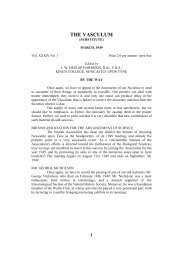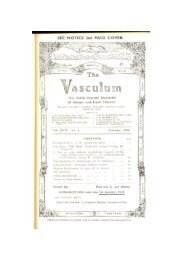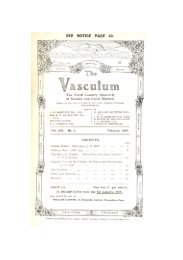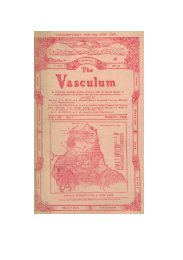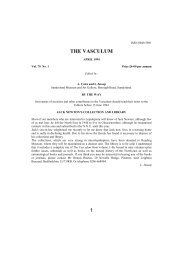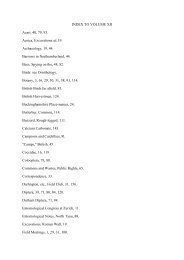1972 - The Vasculum
1972 - The Vasculum
1972 - The Vasculum
You also want an ePaper? Increase the reach of your titles
YUMPU automatically turns print PDFs into web optimized ePapers that Google loves.
Collared Dove: During January and February, up to three pairs were observed in the area of the<br />
Leazes and Exhibition Parks, and the University and Hancock Museum grounds in the centre of Newcastle.<br />
Goldcretst: A pair in the Beamish woods on March 26th.<br />
Kestrel: On March 11th, three kestrels were observed together in an aerial display over Newcastle<br />
University.<br />
Marsh Tit: On April 3rd, a party of three birds were noted in the Causey Woods, whilst during the<br />
same month two pairs were observed in the Beamish woods.<br />
R. Marston Palmer.<br />
<strong>The</strong> Peppered Moth a reversal of a trend ? In the Times of April 5th, <strong>1972</strong>, there is a report from<br />
Manchester of moths changing colour. Until a few years ago, when a programme against smoke pollution in the<br />
North-West began to take effect, zoologists had noticed that moths hiding from predaors on the sides of<br />
Mancheser buildings had black wings.<br />
During the past decade, in which Manchester's air has become steadily cleaner, its sunshine records<br />
improved, the zoologists have recorded that the moths' wings are changing colour to the peppered form. This<br />
matches the cleaned up stonework on the buildings. Hence the trend towards melanism in industrial areas of<br />
Biston betularia L. is in the process of being reversed.<br />
We have not noticed any comparable change in our Durham populations but this is understandable<br />
since we are in the path of pollution being blown from the west. It is more than likely that the effect of smokeless<br />
zones both here and in the west will eventually have a similar result. It will be a worthwhile project for all<br />
naturalists to keep a sharp lockout for Peppered Moths in our areas and report any observations to the Editor.<br />
Mrs. A. N. Gibby.<br />
Barnacle Geese. On May 17th, <strong>1972</strong>, a pair of Barnacle Geese arrived on Joe's Pond, one of the<br />
Trusts's properties. This was a sufficiently unusual occurrence at this time of the year to make a special note of it.<br />
Later it was learnt that two birds had been seen at Barmston Ponds during the previous week, probably the same<br />
pair.<br />
T. C. D.<br />
Spoonbill. A Spoonbill was present on the Barmston Ponds near Washington during part of May<br />
and the greater part of June this year. <strong>The</strong> hypothesis most favoured by the ornithologists is that it was a young<br />
bird hatched jfrom a nest in one of the Dutch colonies earlier in the year. During the usual process of dispersal<br />
from the nesting area after growing up, it had strayed across the North Sea in our direction.<br />
T. C. D.<br />
<strong>The</strong> Glow-worm, Lampyris noctiluca L. On the evening of July 1st, <strong>1972</strong>, the flickering lights of<br />
female Glow-worms were seen quite frequently in Commondale, N. Yorks. It appeared to be more abundant than<br />
is the case in most colonies.<br />
Peter Morgan.<br />
This is a particularly important observation. It is some time since this insect was reported from our area. (Ed.)<br />
RECORDS.<br />
MOLLUSCA SNAILS AND SLUGS<br />
Potamopyrgus jenkinsi. 67<br />
Big Waters; Prestwick Carr.<br />
Carychium minimum. 67<br />
Riverside at Chollerford; Whittle Dene; woodlands at Simonburn; Plankey Mill.<br />
14



